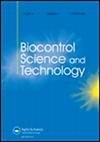金龟子绿僵菌对胃肠道反刍动物游离期线虫的作用及其在土壤中的持久性首次报道
IF 1.2
4区 农林科学
Q4 BIOTECHNOLOGY & APPLIED MICROBIOLOGY
引用次数: 0
摘要
摘要金龟子绿僵菌(Metarhizium anisopliae)是寄生虫防治中研究最多的生物防治剂之一,尤其是在节肢动物防治中。然而,使用这种生物制剂控制反刍动物胃肠道线虫的研究很少。本研究通过体外试验和半自然条件,评价了在水和矿物油中配制的金龟子绿僵菌(Metarhizium anisopliae sensu lato, s.l.)对山羊胃肠道线虫(GINs)自由生活阶段的影响。该研究还评估了真菌在土壤中的持久性。实验分为四组:对照水;控制油;绿僵菌的水制剂;绿僵菌油制剂,每组10罐,用赤花草配制。MG5草。在体外试验中,水剂组和矿物油组对山羊胃肠道线虫的控制效果较好,分别减少45.5%和43%,在半自然条件下,分别减少36% ~ 77.9%和42.6% ~ 90.2%。在体外和半自然条件下的试验中,分离出的绿僵菌s.l.在自由生活阶段被证明对山羊胃肠道线虫有效,试验配方显著减少了幼虫的数量,并在盆栽土壤中保持活性长达52天。本研究提示绿僵菌在反刍动物胃肠道线虫的生物防治中具有潜在的应用价值。本文章由计算机程序翻译,如有差异,请以英文原文为准。
First report of Metarhizium anisopliae s.l. action on gastrointestinal ruminant nematodes in the free-living stage and its persistence in soil
ABSTRACT The fungus Metarhizium anisopliae is one of the most studied biological control agents in parasite control programs, especially when aiming the control of arthropods. Yet, studies using this biological agent to control gastrointestinal nematodes in ruminants are scarce. The present study evaluated the efficacy of the entomopathogenic fungus Metarhizium anisopliae sensu lato (s.l.) formulated in water and mineral oil on the free-living stages of gastrointestinal nematodes (GINs) in goats, by means of in vitro tests and in semi-natural conditions. The study also evaluated the persistence of the fungus in the soil. The experiments were constituted of four groups: control water; control oil; aqueous formulation of M. anisopliae s.l.; oil formulation of M. anisopliae s.l., each group consisting of 10 pots with Urochloa brizantha cv. MG5 grass. In the in vitro test, the groups treated with the aqueous and mineral oil formulation showed efficacy in controlling gastrointestinal nematodes of goats, providing a reduction of 45.5% and 43%, respectively, and a reduction varying from 36% to 77.9% and 42.6% to 90.2%, respectively, in the experiment under semi-natural conditions. Isolate M. anisopliae s.l. proved to be effective against goat’s gastrointestinal nematodes in the free-living stage, in both in vitro and semi-natural conditions tests, by significantly reducing the number of larvae with the formulations tested and remaining active for a period up to 52 days in the pots’soil. This study suggests the potential use of M. anisopliae s.l. for the biological control of gastrointestinal nematodes in ruminants.
求助全文
通过发布文献求助,成功后即可免费获取论文全文。
去求助
来源期刊
CiteScore
3.20
自引率
7.10%
发文量
64
审稿时长
4-8 weeks
期刊介绍:
Biocontrol Science and Technology presents original research and reviews in the fields of biological pest, disease and weed control. The journal covers the following areas:
Animal pest control by natural enemies
Biocontrol of plant diseases
Weed biocontrol
''Classical'' biocontrol
Augmentative releases of natural enemies
Quality control of beneficial organisms
Microbial pesticides
Properties of biocontrol agents, modes of actions and methods of application
Physiology and behaviour of biocontrol agents and their interaction with hosts
Pest and natural enemy dynamics, and simulation modelling
Genetic improvement of natural enemies including genetic manipulation
Natural enemy production, formulation, distribution and release methods
Environmental impact studies
Releases of selected and/or genetically manipulated organisms
Safety testing
The role of biocontrol methods in integrated crop protection
Conservation and enhancement of natural enemy populations
Effects of pesticides on biocontrol organisms
Biocontrol legislation and policy, registration and commercialization.

 求助内容:
求助内容: 应助结果提醒方式:
应助结果提醒方式:


